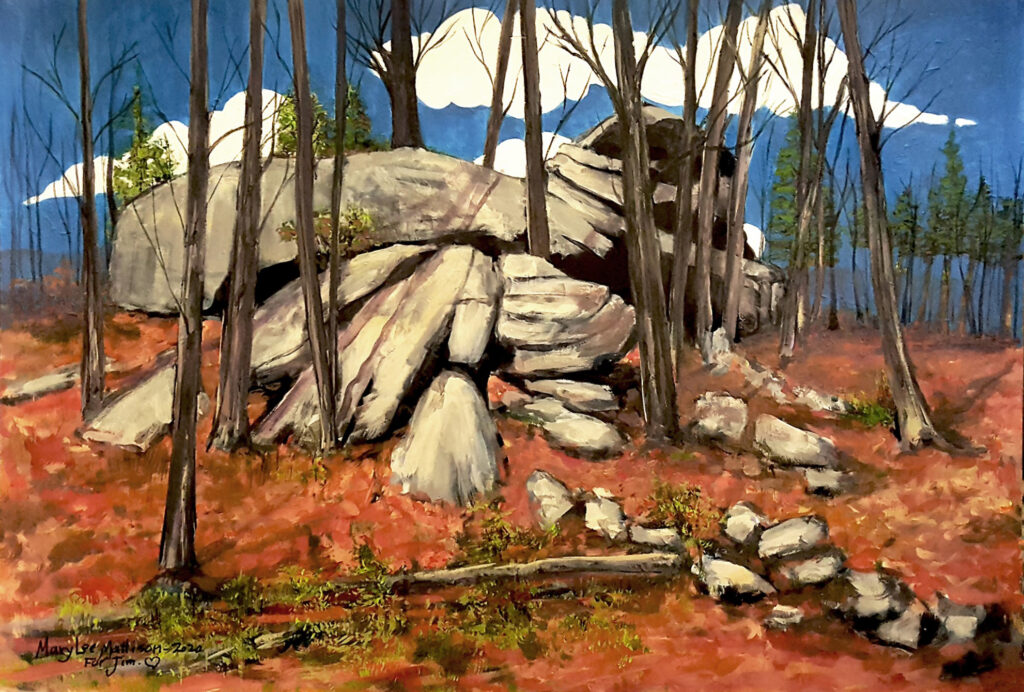
The Great Rocks
My continuing fascination with glacial erratics began at 30 Janet Road in Chelmsford, MA.
My family lived near the end of this sleepy road in a 1960s, residential development. At 40 Janet Road (the end of our street) was a weathered sign proclaiming ‘Thanksgiving Town Forest.’ A little, paved, parking lot, with 4 or 5 parking spots, bordered on a wide, sandy field with a modest beach along the slow, deep current of the Rustle Mill Pond. (As I recall there were never any cars in the parking lot.)
We would scramble up the initial, steep, 10-foot forest boundary, climbing over centuries of fallen pine needles. Always barefoot, we were glad to be off the hot, tar, parking lot and onto the yielding, pine, forest floor. There was a sudden change in the air and light as you entered the Town Forest. It was always hushed and dim. The sky was blocked out by acres of towering evergreens (each oozing with fragrant, syrupy, pine tar.) There were few low branches so you could see through the single, straight trunks to small, random, sunlit glades surrounding fallen trees. (Where a new generation of growth reached out excitedly for the sky, high above.) The Town Forest smelled of sweet, damp, decaying vegetation and warmed, pine needles. The Town Forest was our playground.
Upon entering the Town Forest, you could turn left and walk along a well-worn path that skirted the narrow, mill pond. The banks were steep and muddy where centuries of erosion had cut down through the dense, forest floor leaving huge, tangled, tree roots exposed. I would always turn right. Making my way straight on until I could see the ‘Mushroom Tree’ (one, ragged, hoary pine that towered above all the others) then turn right again.
You would start to feel the rocky spine jutting up from the soft, forest floor way before the thick trunks cleared enough to allow a glimpse of the colossal, cluster of giant boulders. Boulders that were dragged there, by the force of a retreating glacier, a millennium before. (Now freed from the melting ice and ground smooth by erosion they were left here far from their original home.)
The Great Rocks, they were called, because they were great! Gigantic boulders of different kinds of rock piled high upon one another. An impossible sculpture of stones. There were deep worn paths all around the structure and a shallow tunnel and ledges to balance on or to cook pinecones on a small, secret fire. We spent our daylight hours crawling up over the Great Rocks or lying across the smooth, flat top of the largest stone, high in the air, making up magical stories about the stones’ origin or just watching the drifting, white clouds. (No decent pine tree dared grow too close to the Great Rocks.)
The area around the colossal cluster was worn lower than the forest floor from the countless feet that had come to…? Come to what? Make offerings? Gawk in awe? Perhaps a hidden rendezvous or to spend a few moments in a seemingly out worldly place? I don’t know the answer. A 19-century book gives this history of the Thanksgiving Town forest: “it was named for the fox hunt that happened on Thanksgiving Day. All riders met at the giant boulders.” (Which, of course, everyone knew exactly where that was.)
I’m thinking so must the indigenous peoples who had once lived on the land around the Great Rocks. The strange arrangement of mammoth boulders would have been far too spectacular not to inspire legends. Some early, land maps refer to the stones as a boundary marker… “south to the great pile of boulders on the Billerica line. To me they were alive. Like some benign, crouching creature, they had watched over the dense, pine forest for 10 thousand years.
Back to What About Me?
HOME
All images and written content are copyright
Mary Lee Mattison 1/8/1981 All rights Reserved.
Leave a Reply